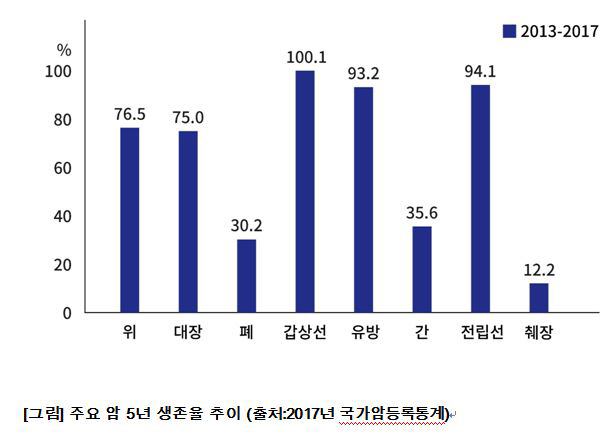The Planning Committee of the Korean Liver Cancer Association said that early diagnosis and prevention are important because liver cancer is the leading cause of cancer death in Koreans.
Liver cancer is a carcinoma that occupies the 6th largest incidence of carcinoma in Korea in 2017 (the incidence of age standardization in 17.0 persons/10 million persons).
The number of liver cancer incidences increased from 13,214 in 1999 to 11,181 in 2010, and was reported to be 15,405 in 2017.
The cancer mortality rate from liver cancer is 1,611 people, which ranks second among the causes of death from carcinoma, and the absolute number of deaths from liver cancer has increased without decreasing over the past 15 years.
In the randomized liver cancer registration project data analysis, the 3-year and 5-year average survival rates of 1655 patients diagnosed with liver cancer in 2008-2014 were 49.3% and 41.9%, respectively, which is significant when compared with the 2008-2011 and 2003-2005 data. Although one can see an increase in survival rate, liver cancer is still a disease with a low survival rate and a poor prognosis.
As a cause of liver cancer, hepatitis B accounted for the largest proportion with 61.1%, alcohol hepatitis 12.5%, hepatitis C 10.6%, and other causes of 8.4%.
In order to prevent the occurrence of liver cancer, early diagnosis and treatment for each underlying liver disease are of paramount importance.
In particular, it is emphasized that subjects with risk factors (cirrhosis, hepatitis B, hepatitis C) undergo liver ultrasound and AFP tests twice a year for early diagnosis of liver cancer through the national examination and promotion of the Liver Association. As the proportion of patients diagnosed with advanced liver cancer is still high, the importance of early liver cancer screening should be further emphasized.
Diseases that cause chronic liver damage include hepatitis B, hepatitis C, alcoholic liver disease, and non-alcoholic fatty liver disease. If inflammation in the liver continues, cirrhosis and liver cancer are caused. In most cases, liver cancer can be prevented and early liver cancer can be diagnosed by finding out whether there is such a disease and performing appropriate treatment and liver cancer surveillance if diagnosed.
Chronic hepatitis B is the main cause of liver cancer in Korea, and accounts for 60-70% of all liver cancer incidences. Although the prevalence of hepatitis B infection has been decreasing since the national vaccination program was implemented in the early 1980s, the 2018 survey found that the percentage of hepatitis B surface antigens remained high at 3.2% in those in their 30s to 50s.
The 5-year incidence of liver cancer in patients with chronic hepatitis B without antiviral therapy is 0.6-2.4%, especially when cirrhosis is accompanied, it increases to 9.7-15.5%. Recently, the use of antiviral treatments for the hepatitis B virus has shown a remarkable decrease in the incidence of liver cancer.In one study, the 5-year incidence of liver cancer in patients without antiviral treatment was 13.7%, compared to 3.7% in patients treated with antiviral drugs. Was low.
In another study, the annual incidence of liver cancer in patients treated with antiviral drugs was 0.37%, and the annual incidence of liver cancer in patients with cirrhosis was 0.65%. Since a large number of hepatitis B patients remain asymptomatic and progress to liver cirrhosis and liver cancer, early screening tests are needed to find those who have hepatitis B virus, and periodic liver cancer surveillance tests and appropriate treatment for those with hepatitis B virus Should be implemented.
Chronic hepatitis C is also a major cause of liver cancer in Korea, accounting for 10 to 15% of all liver cancer incidences. Chronic hepatitis C has no symptoms, so many patients are not aware of the infection, and are often found in advanced conditions such as chronic hepatitis, cirrhosis, and liver cancer.
Unlike hepatitis B virus, unlike hepatitis B virus, a preventive vaccine has not been developed until now, but due to the remarkable development of antiviral drugs recently, oral antiviral drugs can be cured in almost all cases. It is possible. In several studies of chronic hepatitis C patients, the incidence of liver cancer was prevented by more than 70% when hepatitis C was cured through antiviral treatment. However, patients who had already progressed to cirrhosis before the start of antiviral treatment had 4.5 times more liver cancer than those who did not. Therefore, if hepatitis C is diagnosed and treated with antiviral drugs before proceeding to cirrhosis, the occurrence of liver cancer can be prevented in most cases.
Alcohol, along with viral hepatitis, is one of the main causes of chronic hepatitis, cirrhosis and liver cancer, and accounts for 12.5% of liver cancer in Korea. In particular, when chronic hepatitis B or C is accompanied, the risk of liver cancer is significantly higher than that of non-drinkers even with a small amount of alcohol.
Regardless of the type of alcohol, the amount and frequency of alcohol consumption mainly affect the incidence of liver cancer. Reported. Women show a higher frequency of liver damage than men even if they drink the same amount of alcohol due to fewer alcohol-degrading enzymes and higher body fat percentage than men. Safe alcohol intake is less than 2 cups per day in men, less than 1 cup per day in women, and drinking one more cup per day is known to increase the incidence of alcohol-dose-dependent liver cancer. In alcoholic liver disease, drinking alcohol is the most important treatment. Previous meta-analysis results show that drinking alcohol reduces the risk of liver cancer by about 6-7% every year.
The incidence of non-alcoholic fatty liver disease has increased rapidly in recent decades and is now the most common cause of chronic liver disease.
In particular, 60% of diabetic or obese patients over the age of 50 have non-alcoholic steatohepatitis with advanced fibrosis, which can lead to cirrhosis or liver cancer. In most cases of liver deterioration due to non-alcoholic fatty liver disease, when it progresses to liver cirrhosis or liver cancer, the fat in the liver is lost, so it is not known that non-alcoholic fatty liver disease is the cause of the disease. It is estimated that the majority of liver cancer patients are due to this disease.
In a recent study, the rate of liver cancer of unknown cause in Korea reaches 9.5%, and it is known to be on the rise. Non-alcoholic fatty liver disease-related liver cancer is closely related to metabolic syndrome, and it is believed to be caused by cellular and genetic damage due to chronic inflammation. However, as no effective treatment has been established, about 25% of non-alcoholic steatohepatitis patients progress to cirrhosis, and 10-25% of them are predicted to develop liver cancer, so appropriate measures are needed. During high-intensity jogging or active physical activity, the incidence of liver cancer decreases by 44-46%, and the incidence of liver cancer decreases by 30% each time the body mass index decreases by 5 kg/㎡, and the occurrence of liver cancer by drinking one cup of coffee a day. It is known to decrease by about 14%, so it is important to prevent liver cancer through appropriate lifestyle improvement.
The Korean Society of Liver Cancer said, “If liver damage continues due to chronic liver disease, liver cirrhosis and liver cancer occur. Eliminating liver damage through appropriate treatment can prevent the occurrence of liver cirrhosis and liver cancer.” He emphasized that it is important to prevent liver cancer by controlling liver damage by antiviral treatment in case of hepatitis and hepatitis C, abstaining from alcohol in case of alcoholic liver disease, and weight control in case of non-alcoholic fatty liver disease. February 2 of every year is the day of liver cancer, and patients with risk factors must undergo two tests (liver ultrasound/serum AFP) twice a year to diagnose liver cancer early. Reporter Jongho Jang bellho@sportschosun. com
– .


